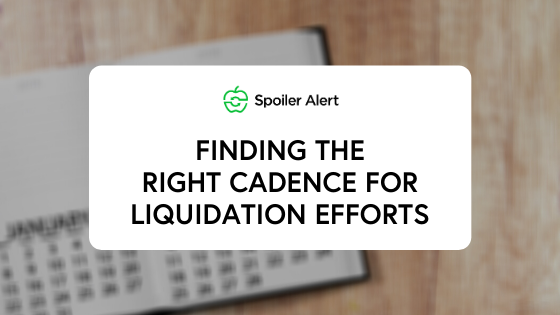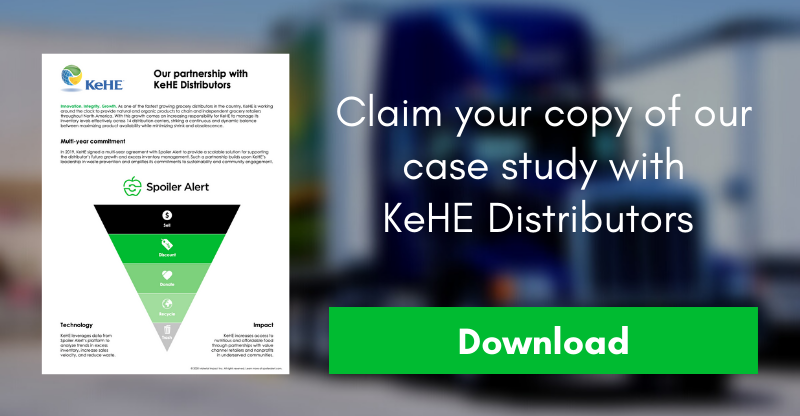
We spend a lot of time with our customers evaluating the cadence of liquidation efforts, and we often get asked, “How often should my company run its liquidation process?” Perhaps unsurprisingly, the answer is, “it depends”. That said and all else equal, A) more frequently (rather than less) is better, and B) more consistently (rather than irregularly) achieves the best results. We’ve outlined the reasons for this below.
There are a number of key factors that should be considered when assessing what is right for different food manufacturers. Variables include upfront data availability, product type and perishability, freight and logistics considerations, operational resources, and customer preferences. We’ll go deeper on these variables in future posts.
For now, we break down the three most common liquidation cadences that we see, the circumstances that are ideal for each, as well as some additional considerations for finding the right cadence for your business.
Three common liquidation cadences
The 3 most common cadences for carrying out liquidation cycles are Continuous, Monthly, and Ad Hoc:
- Continuous: The most rapid cadence we see revolves around a steady weekly (and in some cases, daily) approach to liquidation. More often than not, these efforts get kicked off by a distressed inventory dataset or pre-approved push list from the planning team, typically delivered at the start of a week. Over the course of a week, product availability is communicated out to customers, offers are aggregated and compared, and orders are entered by fulfillment teams, quickly and efficiently. The major benefits of a weekly cycle are consistent liquidation sales volume throughout the month, quicker dispositioning of inventory from facilities, and an increased opportunity to sell inventory.
- Monthly: Companies unable to carry out continuous liquidation cycles are often doing them monthly instead. A monthly cycle can take place over the entirety of a month with extended offer windows, or within a specified timeframe (such as a week) on a monthly cadence.
- Ad Hoc: The last cadence we’ll highlight is infrequent and/or irregular liquidation cycles. There is no regularity to closeout opportunities; when they do occur, the right folks rally to sell. More on this below.
Ideal circumstances for each cadence
While one cadence may be more desirable than another, the reality is that there are often a set of circumstances that necessitate a particular cadence over another. Those circumstances are often the following:
|
Cadence |
Ideal for one or more of the following circumstances: |
|
Continuous |
|
|
Monthly |
|
|
Ad Hoc |
|
We’ll stop short of advocating for a universally preferred cadence, though it is hard for us to view an “ad hoc” approach to liquidation as a recommended strategy - particularly when circumstances exist that align to the continuous or monthly scenarios. This isn’t to say there aren’t companies that have made “ad hoc” work. This might be because they have the luxury of a product mix with longer shelf life or that’s made-to-order, or it might simply be because they are just beginning down the path of establishing a company-wide approach to distressed inventory management.
Regardless, if your company can support continuous or monthly liquidation cycles, do it - as the alternative leaves money on the table.
Additional considerations
Whether you’re new to the game or re-evaluating changes to the cadence of your liquidation strategy, here are some tips and considerations to take into account:
- Ask your customers. Many value channel customers prefer more frequent product availability for opportunistic purchasing, as long as volumes are sufficiently large enough to put together a reasonable order and to justify the freight. More often than not, “more frequently” means more shelf life and faster speed to shelf.
- Assess offer windows. How much time are you giving customers to submit offers? Two hours? Two days? Two weeks? In many cases, the duration of these offer windows can have a meaningful influence on which cadence is feasible or optimal. For example, giving customers 2 weeks to submit offers would make a continuous liquidation cadence difficult, whereas giving customers 8 hours would lend itself to a weekly (or even daily) cadence (recognizing that this may prohibit some customers from participating).
- Look at the data. How does customer engagement change as cadence increases or decreases? Are there any noticeable impacts on sell through rates and cost recovery rates? Does remaining shelf life influence results or introduce greater urgency? Oftentimes these analytics can paint a clear path towards a more optimal outcome.
- Conduct a benefits assessment. A more rapid cadence is often accompanied with higher returns, though it tends to also be more resource-intensive. Are these tradeoffs worth it? Evaluate any potential personnel constraints or data barriers associated with identifying distressed inventory, facilitating the liquidation process, and/or fulfilling the orders. Be sure to collaborate with Supply Chain, Sales, Operations, and/or Fulfillment on these efforts.
- Experiment. Carve out a month or a quarter to experiment with different approaches. Test one approach with a segment of your customers or SKUs and compare the results.
Unclear where to start? We’re here to help. We’ve seen the whole gamut and are always eager to help brands assess what will work best for their business.
.png?width=250&name=SpoilerAlert_WhiteLogo_LeftStacked%20(7).png)
